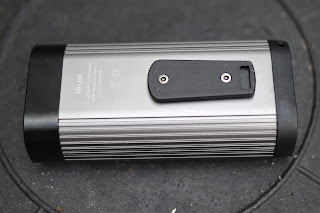The nights are beginning to steadily creep in. A few weeks back, it was still light by 2100, now I've the dynamo and rear blinkie running at 1930 onward. Some would argue running front and rear blinkies is good practice, long before dusk. I'm inclined to agree.
My tubby tourer's Exposure Revo dynamo headlight not only produces a very usable 800 lumens, the standlight lasts longer than most. Therefore, no problems at busy junctions. Nonetheless, anecdotally, it seems car, and other drivers respond faster to a fast tempo of a daylight/similar flash setting. Hence the ORP Smart Horn https://www.sevendaycyclist.com/orp-smart-horn and more recently, this Ravemen LR500S USB Rechargeable Curved Lens Front Light. Clue's in the title, its a compact light with a total (and more potent than figures suggest) of 500 lumens.
In common with its LR1200 counterpart, it uses lens technology, which is designed to provide a pure, consistent, yet road friendly beam. There are four modes. Three steady High (500) medium (300) and low (100), which should cater for town suburban and semi rural contexts, without being impotent, or abrasive.
Run times are cited as a commuting friendly 1.6, 2.8 and 7.5 hours respectively. The rapid flash (200) is reckoned good for 15 In emergency, there's the option of plugging into a portable "power bank" and I also like the wired remote option.
Not that the switch cum battery life indicator is tricky to operate and there's a memory mode. Both the 1200 and 500 brackets are fully compatible with the different units, hence I've swapped between tubby tourer and working fixed. There's also an upside down, Garmin type option, if you're pressed for space, or despise clutter.
An aluminium alloy casing, though not unheard of, at this price point (£34.99) is nice to see. Its shock resistant to 1 metre and complies with PPX 6 for weather repellency. Reassuring.
Even with high power main systems (dynamos, in this instance) I always carry a second compact unit. Should I puncture/similar along a very dark lane, or snag a wire/similar, then I've always got a sensibly powered backup. Most of the time, these just do a different sort of backing singing-flashing away. Now, much to my surprise, I've discovered it has cancelled out the signal from my tubby tourer's simple little Cat-Eye Quick Computer.
I initially put this down to a dead sensor battery, and changed the CR2032 button cell, adding a quick lick of Vaseline to the contacts, while I was there. Spun the wheel, fine. Popped the Ravemem into fast flash the next morning and headed along the lanes. Head unit registered 0 .
Having stopped and double checked sensor/magnet clearances, I switched the Ravemen off. With (almost) immediate effect, the display read 14.3 mph. The moment I reengaged the little Ravemen. 0 .
Shame too, since I was really flying along the flats and descents. In keeping with the Zefal Pro Dry Chain lube https://www.sevendaycyclist.
Anyone will tell you a wired connection is the most reliable. However, I've never experienced this before-with any system. Sure, older wireless models had a reputation for going bonkers, in close proximity to high currents-Pylons, nuclear power stations etc.
88mph uphill anyone? Might just be the relatively close proximity. It's presently on the Velo Orange Handlebar Accessory mount https://www.sevendaycyclist.

























